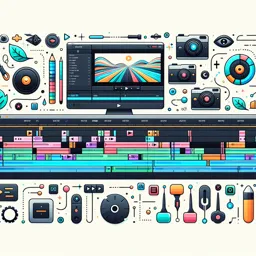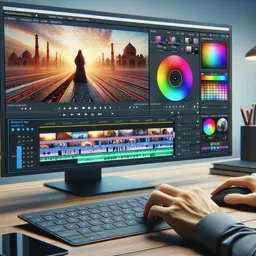DaVinci Resolve is one of the most powerful and feature-rich video editing software available today. Whether you’re a beginner or an experienced editor, this guide will help you navigate the basics of DaVinci Resolve and get started on your video editing journey.
1. Setting Up Your Workspace
When you first open DaVinci Resolve, you’ll be introduced to its clean, yet complex interface. The software is divided into multiple pages for different tasks, such as media management, editing, color grading, and audio mixing.
Key Pages in DaVinci Resolve:
- Media: Organize and import your video files.
- Cut: Quickly trim and make simple edits to your video.
- Edit: The main editing workspace for more detailed video cutting and sequencing.
- Fusion: For advanced visual effects and motion graphics.
- Color: Where professional color grading happens.
- Fairlight: Audio editing and sound design tools.
- Deliver: Export your final video in various formats.
2. Importing Your Media
Before you start editing, you need to import your media files into DaVinci Resolve. Go to the Media page and drag your video, audio, and image files into the Media Pool. You can organize your media into bins to keep everything well-structured.
Steps to Import Media:
- Open the Media tab.
- Drag and drop your media files into the Media Pool or use File > Import.
- Create bins to organize your clips.
3. Making Basic Edits in the Cut or Edit Page
Once your media is imported, head to the Cut or Edit page to start trimming your clips. The Cut page is designed for quick edits, while the Edit page offers more advanced tools for precise cutting and timeline management.
Basic Editing Steps:
- Drag your clips from the Media Pool to the timeline.
- Use the Blade Tool (B) to cut clips where needed.
- Rearrange clips by dragging them around on the timeline.
- Trim the start or end of a clip by dragging its edge.
4. Adding Transitions
DaVinci Resolve includes a wide range of transitions to smooth the flow between clips. Popular transitions include cross dissolves, fades, and wipes.
How to Add Transitions:
- In the Edit page, go to the Effects Library.
- Select Video Transitions and drag your desired transition to the timeline, between two clips.
- Adjust the duration and style of the transition in the Inspector.
5. Basic Color Correction
DaVinci Resolve is famous for its powerful color grading capabilities. To start with basic color correction, go to the Color page. Here you can adjust the exposure, contrast, saturation, and other settings to make your video look more polished.
Basic Color Correction Steps:
- Select your clip and switch to the Color page.
- Use the Color Wheels to adjust shadows, midtones, and highlights.
- Adjust the Saturation and Contrast sliders to enhance the overall look.
6. Adding Titles and Graphics
DaVinci Resolve offers built-in tools to add text, lower-thirds, and graphics to your videos. You can find pre-made templates or create custom titles in the Fusion tab.
How to Add Titles:
- Go to the Effects Library in the Edit page.
- Drag and drop a title template onto the timeline.
- Use the Inspector to customize the text, font, size, and animation.
7. Exporting Your Project
Once you’ve finished editing your video, it’s time to export it. Switch to the Deliver page to choose your export settings. DaVinci Resolve offers presets for YouTube, Vimeo, or custom formats depending on your project needs.
How to Export Your Video:
- Go to the Deliver page.
- Choose a preset from the options (e.g., YouTube).
- Adjust the resolution, format, and compression settings if needed.
- Click Add to Render Queue, then Start Render to export your final video.
Conclusion
DaVinci Resolve provides all the tools you need to create professional-quality videos, even if you’re just getting started. By learning the basic functions of media management, editing, color correction, and exporting, you can begin editing videos with confidence. As you gain more experience, you can explore advanced features like Fusion and Fairlight to further enhance your projects.
































